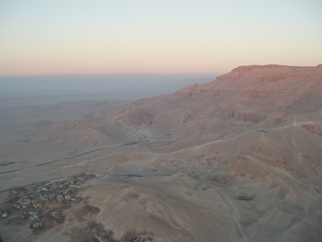4.1 The west bank of the Nile
The area of the desert escarpment on the west bank of the Nile adjacent to Thebes is extraordinarily striking (Figure 13). Seen from the relatively lush green area by the river, the bare mountains glow pink in the morning sun and later in the day achieve a powerful visual effect as the sun sinks behind them. The area had been sacred since the Old Kingdom, not only because of these effects of the light on the rock but possibly also because of the curious natural formation of the peak that dominates the area, which resembles a natural pyramid (Figure 14).


By the Middle Kingdom the West Bank site had become a major cemetery, and a festival route led to it from the temple of Karnak on the east bank of the Nile. In the New Kingdom there evolved an extensive necropolis, the best-known part of which is known to us as the Valley of the Kings, behind which rises the Theban peak. The Valley of the Kings contained royal tombs, of which 63 have now been discovered. Other non-royal burial sites developed nearby in the area around the valley below the royal memorial temples.
There were several festivals during the year, the two most important being the New Year festival and the summertime Festival of the Valley. During this latter festival, the sacred bark of Amun was brought out of its temple at Karnak on the east bank of the Nile, over to the west bank, and carried in a procession. The god was taken to the sanctuary of the goddess Hathor in the royal funerary temples in the ‘Valley’ of Deir el-Bahri (Figure 15).

In the description of Melinda Hartwig, there ‘Amun joined with the goddess to renew the fertility of the land. The bark spent the night floating on a lake of gold surrounded by four basins filled with milk, around which were placed burning torches. In the morning the torches were extinguished in the milk, signifying the return of the dead to Hathor, and the barks of Amun set out again, this time to return to their home at Karnak’.
The festival went on for two days during which time the private tomb-chapels became focal points for social gatherings. The chapels were lit up and feasts were held inside in the presence of the painted banquets depicted on the walls. The deceased’s name was recited and prayers were said according to the instructions of the hieroglyphs that were part of the painted decoration. Many hundreds of these private tombs have now been discovered in this west bank necropolis. One of these contained the now lost tomb-chapel of Nebamun. The exact location is no longer known, but evidence suggests that it was in the area of Dra Abu el-Naga (Figure 16), in the northern half of the necropolis, to the north of the Valley.

